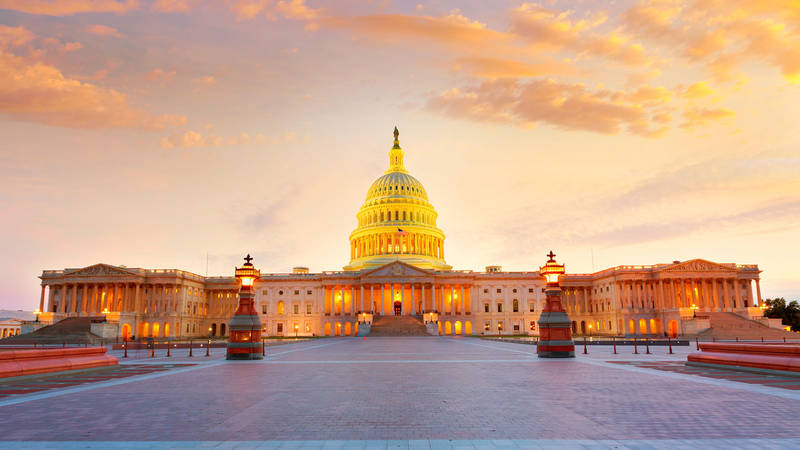The clock is ticking as another budget deadline approaches. Here is what’s at stake for national parks.
Congress has less than two weeks to meet two funding deadlines in early March to prevent a partial government shutdown.
If this feels like déjà vu, you’re not wrong. Congress recently passed its third continuing resolution of fiscal 2024 to temporarily fund the government and give itself an extension to work out what the final funding amounts will be — once again kicking the can down the road.
Over the next few weeks, Congress will consider a number of funding bills, including the House Interior, Environment and Related Agencies appropriations bill, which funds the National Park Service. The current Interior appropriations bill from the U.S. House of Representatives includes deep, historic cuts of 12.5% to the Park Service, totaling $433 million, a nonstarter for anyone who cares for our national parks.
While the size and severity of the final cuts to our national parks remain unknown, funding cuts of any amount would be detrimental to our parks and park staff. And if proposed cuts weren’t bad enough, many anti-environmental policies are also being considered that would put our national parks and their wildlife, clean air and water in harm’s way.
The ramifications of cuts and damaging policies could reach every corner of our national parks, which is why people everywhere should be concerned about these key issues.
1. Park funding cuts would decrease staffing.
National parks have been struggling for decades, operating with fewer staff and smaller budgets to sustain soaring park visitation and address the worsening effects of climate change. Between 2012 and 2022, national parks staffing eroded by 13% while visitation grew by 10%. Though Congress has provided modest increases, those gains have been overshadowed by higher costs of living and inflation on resources needed for critical repairs, which forces park superintendents to make hard decisions regarding how many staff they can employ.
Our parks have been chronically underfunded and understaffed for too long. Previous budget decisions have reduced ranger-led programs, undermined efforts to protect resources, left maintenance needs unaddressed and compromised visitor experiences. Less funding will only make matters worse, hurting the more than 300 million visitors who come to our parks each year to experience the great outdoors and learn about the places and people who have shaped our nation.
If Congress imposes cuts anywhere close to what was included in a bill that passed the House last November, we would see hundreds fewer staff to help visitors and fewer resources to protect natural and culturally historic sites. With warmer weather right around the corner, many national parks are gearing up for the busy season. Park superintendents need dependable budgets to hire seasonal rangers now and plan for the rest of this fiscal year.
National parks have been struggling for decades, operating with fewer staff and smaller budgets to sustain soaring park visitation and address the worsening effects of climate change.
Cuts are just one piece of the larger budget issue at play, as superintendents also must support a mandatory, federal pay raise that went into effect in January. These salary increases are needed as staff struggle to find affordable housing and meet higher costs of living in areas around national parks. However, the National Park Service must find the funds for those raises within its budget while Congress simultaneously proposes steep cuts.
And the possibility of continuing the budget at the same level as the previous fiscal year adds another troubling scenario to the mix due to automatic cuts that were included in last year’s debt ceiling deal. This could lead to deep cuts to the Park Service budget this spring, including the loss of thousands of rangers and significant cutbacks to visitor services that would harm our parks and local economies.
2. Park funding cuts would reduce resource and infrastructure protection.
Through the fiscal 2024 appropriations process, some members of Congress have sought to undermine energy and environmental programs that safeguard our parks, along with Park Service historic preservation funding that is critical to protecting our nation’s history.
Current proposals on the table would slash funding for the Environmental Protection Agency’s clean air and water programs — undoing recent investments to help our communities and park landscapes better face climate change and natural disasters.
Also on the chopping block are climate investments from the Inflation Reduction Act that can help reduce the impacts of rising temperatures, changing sea levels and extreme storms on parks and communities. Climate change is putting our country in crisis, yet some in Congress want to roll back the progress we have made to combat these impacts.
Funding cuts could also further drain already dwindling budgets for recurring national park maintenance. Our parks suffer from more than $22 billion in repair needs due to chronic congressional underfunding. Hundreds of critical repair projects at parks across the country — to fix issues such as crumbling roads, worn-out trails, failing water and sewer systems, and other maintenance issues — have been put on the backburner for decades. Proposed cuts would only make it more challenging for the Park Service to support its infrastructure.
3. Anti-environmental policies would damage parks.
It’s not just reckless funding cuts in the Interior spending bill that are threatening our national parks. Some members of Congress are pushing to include anti-environmental policies in the spending bill that could weaken critical safeguards that protect parks’ natural and cultural resources, wildlife and clean air and water.
Examples include gutting clean water rules that protect the Boundary Waters Canoe Area Wilderness and Voyageurs National Park from mining pollution. Other policy changes seek to block funds to protect iconic species that are essential to park ecosystems, such as the North Cascades grizzly bear, gray wolf and long-eared bat.
Some attempt to clear the way for dangerous and harmful activities within national park borders, such as mining in Grand Staircase-Escalante National Monument. And others strike funding to carry out efforts to ensure diversity, equity, inclusion and accessibility in the federal workforce, including the Park Service and its partner agencies.
These anti-environmental and anti-labor policy riders should be a nonstarter for anyone who values our public lands.
Parks need more, not less.
Members of Congress have long touted their love for America’s national parks and the stories they protect. But the proposed funding cuts and harmful policies currently on the table are out of step with the solutions that are necessary to help preserve our treasured places for future generations to experience. Parks need more — not the status quo and certainly not less.
Our elected officials can and must do better. Congress must quickly come together and pass a spending plan that prioritizes our communities and our national parks.
The views expressed here are those of the National Parks Conservation Association and do not necessarily reflect the views of the National Park Service.
Stay On Top of News
Our email newsletter shares the latest on parks.
About the authors
-
 Angela Gonzales Associate Director, Communications
Angela Gonzales Associate Director, CommunicationsAngela joined NPCA in October 2017 and is an Associate Director of Communications. She currently manages outreach and communications for the Government Affairs team and Conservation Programs.
-
 John Garder Senior Director of Budget & Appropriations, Government Affairs
John Garder Senior Director of Budget & Appropriations, Government AffairsJohn Garder is Senior Director of Budget & Appropriations at NPCA. He is a budget analyst and researcher who advocates for more adequate funding for national parks to diverse audiences, including Congress, the White House, and the Department of the Interior.
-
General
-
Issues


